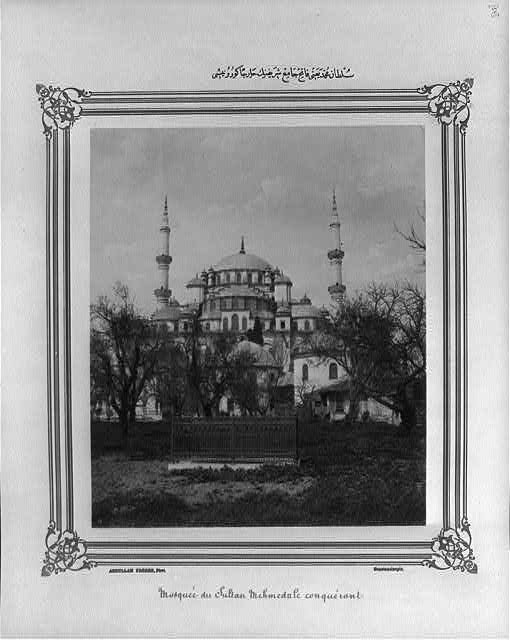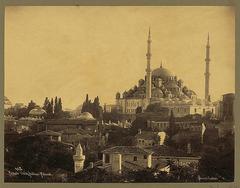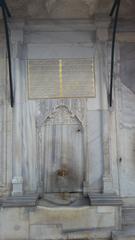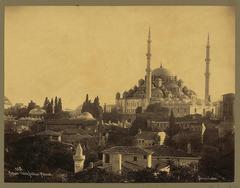
Fatih Mosque Visiting Hours, Tickets, and Istanbul Historical Sites Guide
Date: 14/06/2025
Introduction
Located in the storied Fatih district, the Fatih Mosque (Fatih Camii) is one of Istanbul’s most significant landmarks, reflecting the city’s rich Ottoman and Byzantine legacy. Commissioned by Sultan Mehmed II following his conquest of Constantinople in 1453, the mosque was constructed atop the former Church of the Holy Apostles, symbolizing both the transformation of the city and the dawn of a new imperial era. The design by architect Atik Sinan merged Byzantine grandeur with evolving Ottoman aesthetics, establishing a blueprint for future imperial mosques (Fatih Mosque: A Historical and Visitor’s Guide; Turkey Things).
The mosque was envisioned as part of a larger külliye—a multifunctional complex integrating religious, educational, and social services such as madrasas, a hospital, caravanserai, and public kitchen. Over centuries, the Fatih Mosque has endured significant damage, most notably from earthquakes, leading to extensive reconstructions that have left their mark on its architecture, blending classical Ottoman, Baroque, and Byzantine elements (Teknevia; World Best Mosques).
Today, the mosque remains a vibrant center for worship and culture, open daily to visitors free of charge (outside prayer times), and is conveniently located near other iconic Istanbul attractions such as the Grand Bazaar and Topkapı Palace (Afar). This guide offers essential information on visiting hours, ticketing, etiquette, accessibility, and tips to help you experience one of Istanbul’s most historically and spiritually significant sites.
Table of Contents
- Introduction
- Historical Background & Architectural Significance
- Visiting Fatih Mosque
- Nearby Attractions
- Cultural Life & Local Markets
- Photography Tips
- Frequently Asked Questions (FAQ)
- Conclusion
- References
Historical Background & Architectural Significance
Foundation & Early Design
Commissioned by Mehmed II and constructed between 1463 and 1470, Fatih Mosque marked a new era for Ottoman imperial architecture. Built on the site of the former Church of the Holy Apostles, the mosque signified both religious and political transformation in the city. The architect, Atik Sinan, drew on both Ottoman and Byzantine traditions, designing a central dome supported by semi-domes, an arrangement inspired by Hagia Sophia but adapted to Islamic worship (istanbulprivatetour.net).
The original külliye included eight medreses, a hospital, library, caravanserai, public kitchen, and other social support structures, reflecting the Ottoman vision of a mosque-centered community (worldbestmosques.com).
Earthquake Damage & Reconstruction
Fatih Mosque has undergone multiple reconstructions due to earthquake damage—most notably the catastrophic quake of 1766, after which it was substantially rebuilt in 1771 by Mehmet Tahir Ağa. This reconstruction introduced Baroque elements while retaining Ottoman principles and preserving certain original features such as the main entrance portal, sections of the courtyard, and the tombs of Mehmed II and his wife (teknevia.com).
Notable Features
- Central Dome: The mosque’s defining feature is its 26-meter-wide dome, rising to 44 meters and supported by four massive pillars and four semi-domes, reflecting the influence of Hagia Sophia (worldbestmosques.com).
- Minarets: Two minarets flank the mosque, with lower sections dating to the 15th century and upper parts rebuilt in the 18th century (istanbulprivatetour.net).
- Courtyard & Külliye: The spacious marble-paved courtyard is surrounded by arcades and serves as a tranquil space for gathering and reflection. The broader complex once contained educational and social service buildings, some of which remain accessible.
- Interior Ornamentation: The mosque’s interior showcases Ottoman artistry—floral and geometric tilework, calligraphy, stained-glass windows, and intricately decorated mihrab and minbar (worldbestmosques.com).
- Tombs: Mehmed II’s türbe is a key pilgrimage site, featuring ornate Baroque decoration. The mausoleum of Gülbahar Hatun, his wife, is also within the complex (artandthensome.com).
Ottoman-Byzantine Stylistic Synthesis
Fatih Mosque stands as a pivotal example of the synthesis of Ottoman and Byzantine architectural traditions, combining the central dome plan and spatial arrangement of Byzantine churches with distinctly Ottoman decorative arts and urban planning (istanbulprivatetour.net).
Restoration & Preservation
Restoration efforts have been ongoing since the 18th century, with major campaigns in the 20th and 21st centuries focusing on structural reinforcement, cleaning, and interior restoration. Recent projects have enhanced accessibility and introduced amenities such as a library, museum, and conference space (teknevia.com).
Visiting Fatih Mosque
Visiting Hours & Ticket Information
- Hours: Open daily from 9:00 AM to 6:00 PM. Closed to non-worshippers during prayers, especially on Fridays at midday.
- Tickets: Entry is free for all visitors. Donations to support mosque upkeep are welcome but not required.
Getting There
- Location: Fevzi Paşa Caddesi, Fatih, 34083 Istanbul, Turkey.
- Public Transport: Closest tram stop is Aksaray (T1 line)—about a 15–20 minute uphill walk. Numerous bus routes serve the Fatih district. Taxis are widely available.
- On Foot: Approximately a 30-minute walk from the Grand Bazaar (Afar).
Accessibility & Facilities
- Wheelchair Access: Main entrances and courtyard are wheelchair accessible, though some historic areas have steps or uneven surfaces.
- Restrooms: Public restrooms are available on site.
- Shoe Storage: Shoe racks are provided at the entrance; shoes must be removed before entering the prayer hall.
Dress Code & Visitor Etiquette
- Dress Code: Modest attire is required. Men should wear long trousers and sleeved shirts. Women should wear long skirts or trousers, long-sleeved tops, and a headscarf (Turkey Travel Planner; Walks in Istanbul).
- Etiquette: Maintain silence, silence mobile devices, and supervise children. Photography is allowed without flash, but avoid photographing worshippers without permission. Do not walk in front of people during prayers or enter the main prayer hall if prayers are ongoing (Istanbul Trails).
Guided Tours & Events
- Guided Tours: Available through local guides and agencies; often provide rich historical insights.
- Special Events: The mosque hosts religious ceremonies and cultural events, especially during Ramadan and Eid. Check local listings or the mosque’s website for schedules.
Nearby Attractions
Expand your visit to include these nearby Istanbul historical sites:
- Grand Bazaar: Historic covered market.
- Topkapı Palace: Former Ottoman imperial residence.
- Süleymaniye Mosque: Another masterpiece of Ottoman architecture.
- Hagia Sophia: Iconic former Byzantine church and mosque.
- Wednesday Fatih Market (Çarşamba Pazarı): A vibrant weekly market near the mosque (Afar).
Cultural Life & Local Markets
The Fatih district is alive with traditional shops, cafes, and markets. The call to prayer echoes through the bustling streets, connecting visitors with Istanbul’s daily rhythms and Ottoman heritage. On market days, the area around the mosque is especially lively, offering a chance to experience authentic Istanbul local life.
Photography Tips
- Best Times: Early morning or late afternoon for soft, flattering light.
- Photo Spots: The mosque’s exterior, the courtyard, and inside the prayer hall (respecting worshippers).
- Details: Capture stained-glass windows, the mihrab, and intricate tilework.
- Etiquette: Avoid flash and be discreet.
Frequently Asked Questions (FAQ)
Q: What are Fatih Mosque’s visiting hours?
A: Open daily from 9:00 AM to 6:00 PM. Closed to non-worshippers during prayer times, especially Friday midday.
Q: Is there an entrance fee?
A: No, entry is free. Donations are welcome.
Q: Are guided tours available?
A: Yes, through local guides and agencies.
Q: Is the mosque accessible for people with disabilities?
A: Main areas are accessible; some historic sections have steps.
Q: What is the dress code?
A: Modest attire—long trousers and sleeved shirts for men; long skirts/trousers, long sleeves, and a headscarf for women.
Q: Can non-Muslims visit?
A: Yes, outside of prayer times.
Q: Can I take photographs?
A: Yes, except during prayers and without flash.
Conclusion
Fatih Mosque is a living monument that bridges centuries of Istanbul’s history, offering visitors a unique blend of spiritual atmosphere, architectural splendor, and cultural vibrancy. Its free entry, accessible location, and proximity to other major landmarks make it an essential stop for any Istanbul itinerary. To make the most of your visit, plan around prayer times, adhere to dress codes, and immerse yourself in the surrounding Fatih district.
Download the Audiala app for real-time updates, guided tours, and tips on exploring Istanbul’s historical sites. Follow us on social media for the latest travel insights and inspiration.
References and Further Reading
- Fatih Mosque: A Historical and Visitor’s Guide to One of Istanbul’s Most Iconic Sites
- Fatih Mosque Istanbul: Visiting Hours, Tickets, History & Tips
- Fatih Mosque in Istanbul: Visiting Hours, Tickets, and Architectural Highlights
- Fatih Mosque Overview
- Fatih Mosque and Surroundings
- Mosque Etiquette and Dress Code
- Mosque Dress Code in Istanbul
- Mosque Rules and Etiquette
























































































































